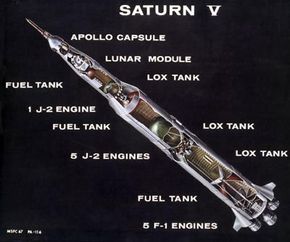An Overview of the Spacecraft
On the launchpad, the combination of the Apollo spacecraft and Saturn V launch vehicle was an imposing sight.
It was more than 400 feet (121.9 meters) tall, and from its base to its top consisted of:
Advertisement
- The launch vehicle, which was the three-stage Saturn V rocket in all manned Apollo missions. The Saturn V's job was to launch the Apollo spacecraft into space.
- Then there's a structure that looks like a cone with the tip cut off. It was called the spacecraft lunar module adapter (SLA). It protected the lunar module (LM), which couldn't withstand the stress of traveling through the Earth's atmosphere at high speed. The LM was the part of the Apollo spacecraft that actually landed on the moon.
- The service module (SM) was next. The service module contained many of the Apollo spacecraft's important systems, including oxygen tanks, fuel cells, batteries and engines. Once the spacecraft separated from the final stage of the Saturn V, the SM provided the thrust needed to adjust the spacecraft's trajectory, pitch, roll and yaw (the rotation about the three axes of the spacecraft).
- Above the SM was the command module (CM), where the astronauts sat for most of the mission. The CM contained the array of controls and displays the astronauts used to monitor the spacecraft's integrity and performance. Many of Apollo's functions were automatic, but astronauts had to initiate some of them and could choose to switch other functions to manual control if necessary. The CM also had many of the same systems that the SM had, both to act as a backup and to control the spacecraft's entry into the Earth's atmosphere at the end of a mission.
- Finally, on top of the CM was the launch escape system (LES). It was a tower-shaped structure that looked like a small rocket on top of a trellis. The purpose of the LES was to provide the astronauts a quick means of escape in case of a launch failure. In such a situation, the LES would pull the CM away from the launch vehicle using three solid propellant rocket engines.
In contrast, when the Apollo spacecraft re-entered the Earth's atmosphere and landed in the ocean, it was just shy of 11 feet tall. That's because NASA intended for only the command module to return to Earth in one piece -- everything else was jettisoned either over the Atlantic Ocean or into space.
The cost of the program was estimated at more than $25 billion, which would be more than $100 billion today when adjusted for inflation [source: NASA]. Most of that money was spent designing, building and refining the complex systems and machinery required to transport men to and from the moon safely. NASA allocated the rest of the budget for astronaut training, ground control systems and related expenses.
Now that we've got an overview, let's take a closer look at each of these components. We'll start with the Saturn V launch vehicle in the next section.
